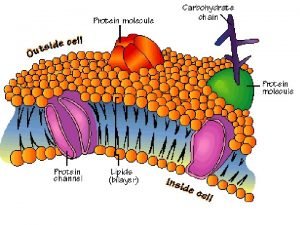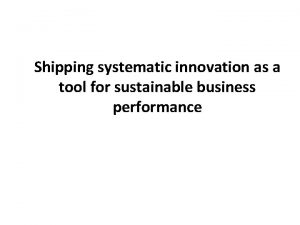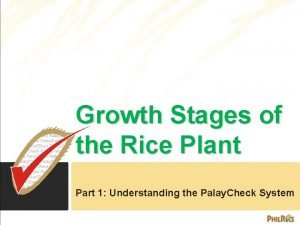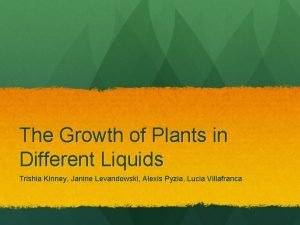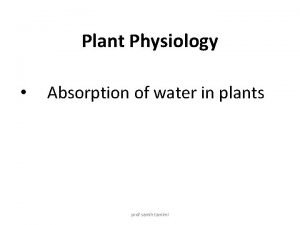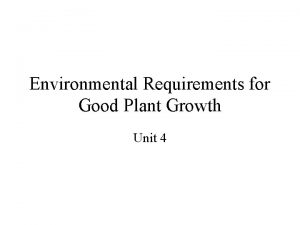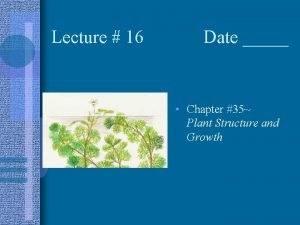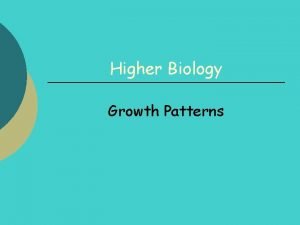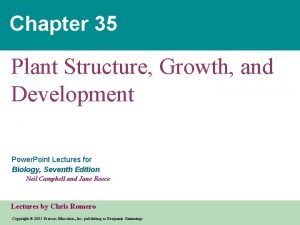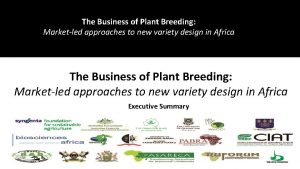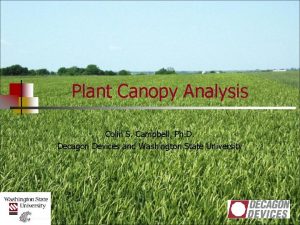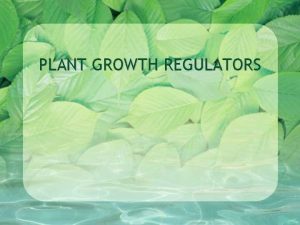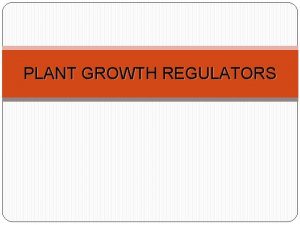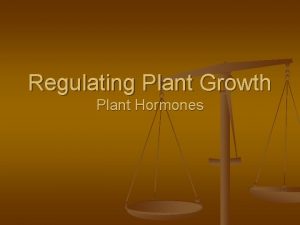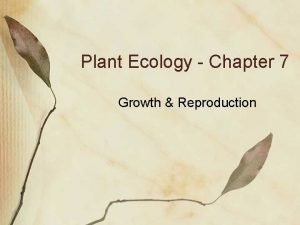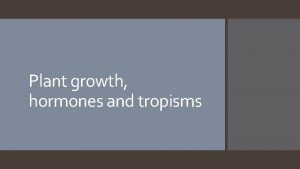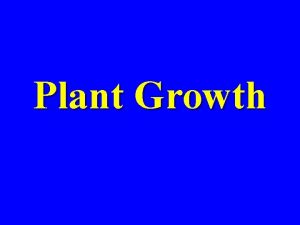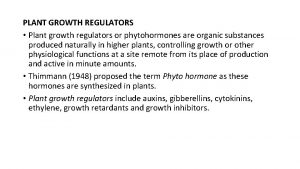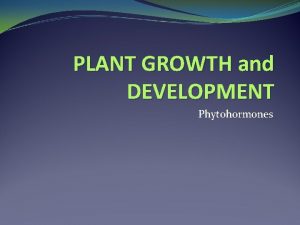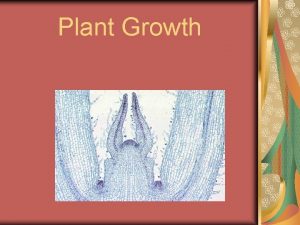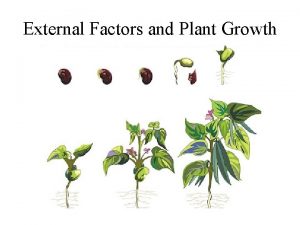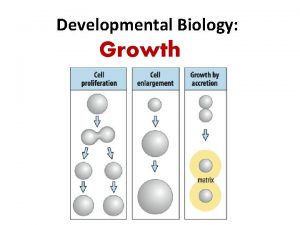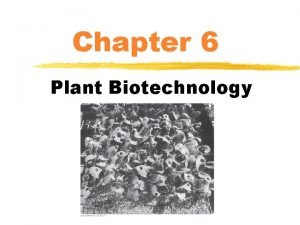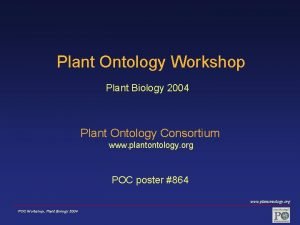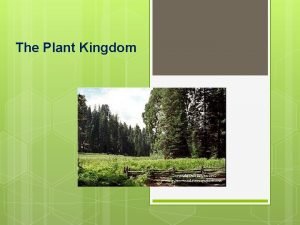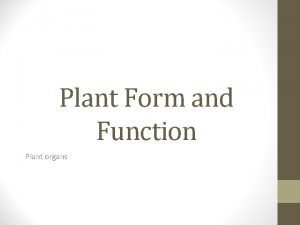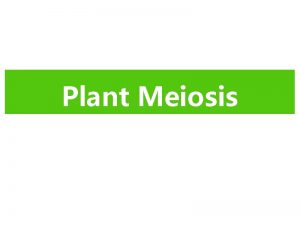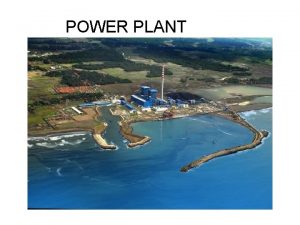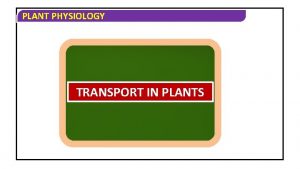Plant Growth Analysis Growth Growth is defined as


































- Slides: 34

Plant Growth Analysis ØGrowth - Growth is defined as an irreversible increase in size of a plant or a plant part. Therefore growth describes a quantitative change in a plant or a plant part. ØDevelopment - Development is defined as a qualitative change occurring in a plant. e. g: -Initiation of leaves, roots and flowers.

Growth Analysis ØIt describes a series of techniques to quantify plant growth.

Objectives of growth analysis Ø To compare the growth of different species. Ø To compare different varieties (Genotype) of the same species. Ø To compare growth of different plant parts Ø To estimate effect of different environmental factors on crop growth. E. g. : - Effect of temperature on rice Ø To evaluate effect of different levels of a given management practices. E. g: - effect of different frequencies of irrigation on the growth of rice. Ø To determine the net result of different physiological process within a plant. Net result of photosynthesis, respiration

Measurement in plant growth analysis ØDry weight Weight of a plant or plant part after it is oven dried at 800 C at least for 48 hours. It is a measurement of the actual dry matter present in a given sample. ØLeaf area

Growth Curve The graphical representation of variation in total dry weight with the time is called growth curve.

Cont… ØThis shape is known as sigmoid, hence the growth curve also known as the sigmoid curve. ØSlope of the growth curve -Slope of the growth curve describes the dry weight increases per unit time. This is the growth rate.

Phases of the growth curve and their physiological basis ØFive different phases can be identified in the growth curve. Phase 1 - Lag phase ØDuring this phase total dry weight increases at a very slow rate. ØTherefore the slope of the curve is very low.

Physiological basis-Phase 1 ØThis phase occurs just after germination. ØDuring this stage the plant uses the nutrients stored in the seed and begins to develop above ground shoot system. i. e. Stem, leaves and below ground root system. ØDuring lag phase the foliage canopy is very small and very little light interception occurs. As a result the photosynthetic rate is low. ØTherefore the dry weight increases very slowly during lag phase.

Phase 2 - Exponential phase During this phase total dry weight increases at an increasing rate. Therefore the slope of the curve increases rapidly.

Physiological basis-phase 2 ØDuring this phase the foliage canopy grows rapidly with increased leaf initiation and expansion. ØConsequently light interception also increases rapidly causing a significant increase in the photosynthetic rate. ØThis causes the total dry weight to increase at an increasing rate. ØIt is important to note that during exponential phase a high proportion of photosynthetic tissues are produced. ØPhotosynthetic tissue -Leaves and other green parts ØNon photosynthetic tissue -Roots, Stems

Phase 3 - Linear phase ØDuring this phase total dry weight increases at a constant rate. ØTherefore the slope of the curve is constant.

Physiological basis ØDuring the linear phase also the foliage canopy continues to grow and light interception continuous to increase. ØTherefore a continuous increase occurs in the crop dry weight due to increase photosynthesis. ØHowever in addition to photosynthetic tissue a significant proportion of non photosynthetic tissues also increases. ØHere another important physiological process determines the variation of growth rate of plants i. e. Respiration.

Cont…. ØRespiration is the process that generates energy for all physiological and metabolic process taking place in plant tissue and cells. ØPart of the dry matter produced used for respiration. ØIn photosynthetic tissue both photosynthesis and respiration occurs. ØOn the other hand in non photosynthetic tissue only respiration occurs. ØTherefore with increasing proportion of non photosynthetic tissue during linear phase the overall respiration increases.

Cont…. ØThe net result of: ØThe increasing photosynthesis (due to continuous canopy growth and light interception) ØAnd increasing respiration (due to increasing proportion of non photosynthetic tissue) ØPlant dry weight increases at a constant rate.

Phase 4 - Declining phase ØDuring this phase total dry weight increases at a decreasing rate. ØTherefore the slope of the curve decrease gradually until it becomes zero at the end of declining phase.

Physiological basis This phase occurs due to two reasons. ØFurther increase in non photosynthetic tissues. ØMutual shading When leaves are produced continuously the canopy develops several leaf layers. In intercepting the incident solar radiation leaves in the top leaf layers would intercept most of the light. Therefore leaves in the middle and bottom layers become shaded and receive very little light energy.

Cont…. ØThis phenomenon is called mutual shading. ØMutual shading decreases the photosynthetic rate of middle and bottom layers of the canopy. ØAlthough the photosynthetic rate of these leaves decrease due to mutual shading their respiration rate does not decrease. ØAs a result from the middle and bottom of the canopy are contributed towards the overall dry weight increase.

Cont…. ØBecause of above two reasons the rate of dry weight increase is decrease gradually during declining phase. At the end of declining phase growth rate becomes zero and the total dry weight reaches maximum.

Phase 5 - Negative phase ØDuring this phase total dry weight decreases with time. ØTherefore the slope of the curve is negative.

Physiological basis This phase occurs due several reasons. Ø Stopping of leaf growth. - Production of new leaves stop after crop passed a certain stage. Therefore light interception and photosynthesis do not increase further. Ø Leaf ageing (Senescence) -With increasing age of leaves their photosynthetic rate decreases while the respiration rates increases. Consequently after certain stage dry matter production through photosynthesis becomes lower than dry matter loss through respiration.

Cont…. Ø Leaf fall (Leaf shedding) -During the latter part of a crops life cycle senesced (aged) leaves are shed. This also contributes to the decrease of total dry weight during negative phase.

Growth Indices The growth curve gives a general description of the plant/ crop growth. However when we want to make specific comparisons between crops, varieties, environment conditions or management practices different growth indices are used.

Cont…. e. g: - ØAbsolute Growth Rate (AGR) ØCrop Growth Rate (CGR) ØRelative Growth Rate (RGR) ØNet Assimilation rate (NAR) ØLeaf Area Index (LAI) ØLeaf Area Duration (LAD)

Crop Growth Rate (CGR) Ø Definition – Increase in total dry weight per unit land area of a crop per unit time. CGR = × ØWhere, W 1 & W 2 are total dry weights of crops over a sampling area of A at times t 1 and t 2 days after planting.

Cont…. Weaknesses Ø Other than giving quantitative estimate of growth of a crop CGR does not provide any insights into the underlying physiological mechanisms. Ø CGR is a poor indicator of the biomass production efficiency of a crop. Ø The most common units are g m-2 d-1, g m-2 week-1 or kg ha-1 week-1

Absolute Growth Rate (AGR) Definition – Increase in total dry weight per plant per unit time. [Note: - this growth index is used specifically to quantify growth of single plants (eg: in pot experiments) where the components of a crop (i. e. a plant population) spread over a given land area is absent. ] AGR=

Cont…. ØWhere, W 1 and W 2 are total dry weight per plant at times t 1 and t 2 respectively. ØWeakness same as CGR ØUnits: - g d-1 or g week-1

× Relative Growth Rate (RGR) Definition – Increase of total dry weight per unit time per unit of existing total dry weight. RGR= X Ø Where, W is the mean total dry weight during the period (t 2 -t 1) Ø During the linear phase of the growth curve W can be calculated as the simple arithmetic mean of W 1 and W 2.

Cont…. Ø RGR quantifies the efficiency of existing biomass in producing new biomass. Ø Units: - g g-1 d-1, mg g-1 d-1 or g g-1 week-1 RGR decreases with age as an increasing part of the plant is structural rather than metabollically active

Net Assimilation Rate (NAR) Definition – Increase of total dry weight per unit time per unit leaf area. (Note: - It defines the efficiency of biomass production specifically in terms of the amount of photosynthetic tissue. ) NAR= X

Cont…. Where, LA is the mean total leaf area over the (t 2 -t 1) period. LA can be calculated for any stage of the growth curve using the following formula. LA= Therefore, NAR= X Units: - g m-2 d-1 or g m-2 week-1

Leaf Area Index (LAI) Definition – Amount of one sided leaf area of a crop per unit land area. LAI= Ø Where, LA is the total one sided leaf area of a crop sample covering a land area of A. Ø Unitless index. Ø Rate of leaf area determines the rate of increase in the photosynthetic capacity of the plant

Leaf Area Duration (LAD) LAD is defined as the integral of the LAI with time. LAD = ʃt f(LAI) dt 0 It indicates the duration for which a certain canopy size is maintained in the field. It is a combined measurement between leaf area and time.

Cont…. Therefore; Ø LAD indicates the total opportunity of the canopy for radiation interception. Ø Ø LAD is also given by the area under the LAI vs time curve. An approximately LAD can be calculated for a period t 2 – t 1 between to successive measurements of LAI (LA 1 and LA 2) as, Ø LAD = ½ (LA 1 + LA 2 ). ( t 2 – t 1)
 It is a collection of well defined object
It is a collection of well defined object Relative growth rate equation
Relative growth rate equation Concentration gradient
Concentration gradient Economic growth is defined as
Economic growth is defined as Economic growth is defined as
Economic growth is defined as Introduction in plant breeding
Introduction in plant breeding Taichum
Taichum Plant introduction in plant breeding
Plant introduction in plant breeding Tronsmo plant pathology and plant diseases download
Tronsmo plant pathology and plant diseases download Tronsmo plant pathology and plant diseases download
Tronsmo plant pathology and plant diseases download Tronsmo plant pathology and plant diseases download
Tronsmo plant pathology and plant diseases download Plant biology ppt
Plant biology ppt Rice growth phases and stages
Rice growth phases and stages Stages of rice plant
Stages of rice plant Plant growth with different liquids
Plant growth with different liquids Significance of transpiration
Significance of transpiration Seeds vs spores
Seeds vs spores Environmental requirements for good plant growth
Environmental requirements for good plant growth Chapter 35 plant structure growth and development
Chapter 35 plant structure growth and development What is growth in biology
What is growth in biology Plant structure growth and development
Plant structure growth and development Primary growth and secondary growth in plants
Primary growth and secondary growth in plants Eudicot
Eudicot Carothers equation
Carothers equation Primary growth and secondary growth in plants
Primary growth and secondary growth in plants Geometric vs exponential growth
Geometric vs exponential growth Neoclassical growth theory vs. endogenous growth theory
Neoclassical growth theory vs. endogenous growth theory Difference between organic and inorganic growth
Difference between organic and inorganic growth Path analysis in plant breeding
Path analysis in plant breeding Miniso sunlit ricefield
Miniso sunlit ricefield Sales growth analysis
Sales growth analysis Piecewise function examples with answers
Piecewise function examples with answers Work physics
Work physics Finance can be defined as
Finance can be defined as Strand for cooking
Strand for cooking


